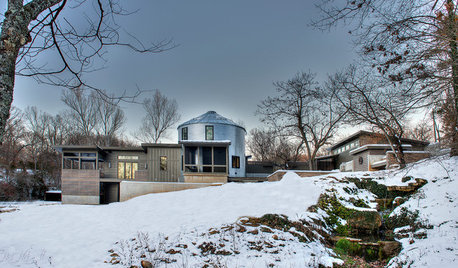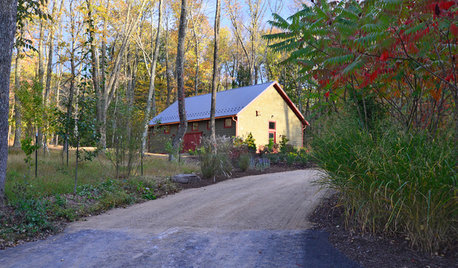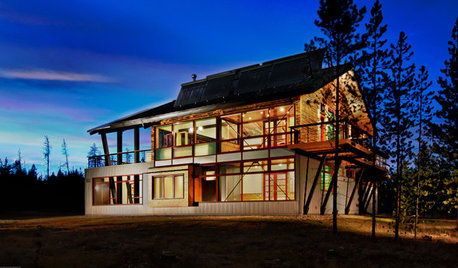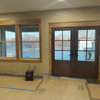builder is advising against foam board insulation
because the house will be brick it would need to be stepped off an extra inch? to accomodate the foam. they say will be.fine with r15. what you all think?
Comments (47)
virgilcarter
11 years agoI don't know where you live and your climate, but adding rigid exterior insulation panels is always a good idea. I'd discuss further with your builder.
The problem, in your case, may be that the builder did not allow for it when pouring the foundation and the "brick ledge". Rather that say that, s/he may be just saying "it will be alright without it".
Of course, it will be alright--houses have been built for hundreds of years without rigid exterior insulation panels. Your house just won't be as tight and energy efficient, that's all!
Good luck on your project.
renovator8
11 years agoBadfish22 is in north Florida so the energy code requirement for the walls is only R 13.
Foam board in the cavity would require the foundation notch to be an inch wider and would save some energy and HVAC equipment cost but not much compared to the places north and south of it.
Related Professionals
Ferry Pass Architects & Building Designers · Nanticoke Architects & Building Designers · Delano Home Builders · Roseburg Home Builders · Bay Shore General Contractors · Berkeley General Contractors · Broadview Heights General Contractors · Country Club Hills General Contractors · Deer Park General Contractors · Hartford General Contractors · Klamath Falls General Contractors · La Grange Park General Contractors · Martinsville General Contractors · Signal Hill General Contractors · Villa Park General ContractorsCamG
11 years agoI found that this was the case with a number of builders. It's clear that in most instances, it makes sense to do rigid foam board, but this involves significant changes to a number of other parts of the build (brick ledge, doors, windows, etc.) and unfamiliar builders will not be excited about the extra effort.
If foamboard is not an option, either because the foundation has already been poured or your builder is refusing and you don't wish to find another, have you considered flash and batt (involving a layer of closed-cell spray foam along the exterior wall plus conventional fiberglass or cellulose insulation in the rest of the cavity)? I have been told by many people that this is inferior to exterior foamboard, but it is still clearly better than conventional 2x4 or 2x6 walls, and does not require any other changes to the building. There is certainly additional cost associated, but it provides a very tight air barrier and significantly improves the overall R-value of the wall. At least this is what my research into the matter has shown.
ETA: Maybe in North Florida flash + batt would not be worth it?
This post was edited by CamG on Wed, Jan 9, 13 at 10:08
worthy
11 years agoOops!
If the foam were part of the original contract, I would expect the builder would use a higher density insulation in the walls to at least meet the Clear wall R value of the structure he was supposed to have built.
Unless you're in the southern third of the continental US, R 15 is pretty minimal.
User
11 years agoIs there any place in America where R-15 is still allowed? That's is a VERY low R value. Even if you live in a warm location, extra insulation now will save you money FOREVER on your cooling costs, which are usually more than heating costs.
badfish22
Original Author11 years agothanks for the repsones. the house has not been built yet. code in florida is r13 in walls only. at this point thinking it is not worth it. we are already doing spray foam in attic.
worthy
11 years agoTo figure the payback period for the increased insulation, you can use the US Department of Energy's ZIP CODE calculator or the more complex Home Energy Saver calculator.
The key point often missed when it comes to exterior sheathing is that it raises the whole wall R value by a much greater percentage than the R3.5-R5 value of the insulation. See the Oak Ridge Laboratory's Whole Wall R Value calculator.
renovator8
11 years ago"Is there any place in America where R-15 is still allowed?"
The 2009 IECC allows R-13 in the southeastern third of the country. The rest of the country is R20 (or R13+5) with R21 along the northern boarder including Alaska.
Some communities have stricter requirements than the state code.
energy_rater_la
11 years agoits worth it.
brick ledge would need to be wider.
windows & doors frames adjusted.stopping the thermal bridging, adding
tight air/insultion barrier to exterior
is a great idea.
check buildingscience.comdavid_cary
11 years agoHollysprings - I live in NC and my cooling costs for last year (hottest year on record) were $200 for the year. I have r-13 walls. It is a common misconception that cooling costs more than heating. I also have 40 windows and 37 of them are oriented East or West with no mature trees - basically a worst case scenario for cooling. We do have some porches/decks but just 3 west windows are covered and 4 east windows.
In my climate in a reference house by audit, the cooling was $450 and the heating was $1350. Our numbers are far lower than that but even in NC which is considered the South, we are 3 times cost on heating vs cooling (obviously each house varies considerably).
Rigid foam in FL is a nice to have but 50+ year payback. Heat comes in through windows in the form in solar gain. Walls are nothing. My audit has walls being about 15% of cooling load or $60 a year (and our costs our 50% of that reference) - so in my house $30 a year. Foam would save about $12 of that.... in a 5000 sqft house. Payback way over 100 years for cooling alone.
badfish22
Original Author11 years agodavid, i agree with you 100% that heat is way more expensive than cooling in our area. so all you have is r13 in the wall and thats it? what about the roof? thanks again.
energy_rater_la
11 years agoR-13 is code here. lots of good ol boys
on builders association & in political office.
we still get away with R-6 in the attic which
is just insane.no way that payback for foam sheathing is 50 year
payback. foam in walls is 25-30 year payback
in a 2500 sq ft home. foam sheathing is 2-5 years.you'll just have to stand your ground with your builer.
learn how to do it, and be on site to show them.
then and only then will you get better than R-15
for your walls. with R-15 you'll have higher energy
bills every month as opposed to using a little foresight
to do it better than minimum allowed.there is no doubt that windows and doors are the
weakest part of the walls. so you buy better windows.
low-e, argon filled windows with frames that don't
transfer heat. solar heat gain coefficients
and u-factors should be .30 or lower.
use external shading..increase overhang size
add porches..lots of ways to over come these
issues. google nfrg label to learn about what
types of windows to buy. shop only brands
that have this certification. or again..you'll
pay monthly for the life of the windows.
efficiency cost is always upfront. always.
savings is life of the item.david has a high amount of windows. without knowing
what type or much about his situation, there
were many ways to deal with reducing the heat gain.running the numbers on the software we use as raters,
you quickly see the benfits of what works and
what doesn't. what pays back soon enough to be used
and what should be avoided.
rather than having the experience of building a personal
home, we rate lots of homes every year.
what folks like me do is to help the homeowner
to make sensible affordable energy efficient homes.
www.resnet.usbest of luck.
badfish22
Original Author11 years agodang that was a long post. What brand foam sheating and what is the cost please.
Brian_Knight
11 years agoTechnically, a 2x4 wall with FG batts might be closer to 11 than 15 depending on the quality of install and efficiency of framing. That would probably put you below code but its usually not enforced.
I tend to agree with david that it may not be worth it. Cooling dominated climates dont have the Delta T to make higher R walls "pay off". That being said, a layer of 1/2" foil faced Isocyanurate exterior sheathing is probably a good investment if you have a competent builder.
The thing that's getting missed in this discussion is the airtightness level of the home. What are your ACH50 blower door test goals? If you dont have any then you are probably fretting over the wrong details.
Spray foam in the walls is more beneficial for the air sealing properties than R value in your climate. That being said, I bet I could build a tighter home with NO spray foam in the walls than most builders could with. Its more about the connections and less about the wall assembly.
If you havent already, I would research and set some goals for your blower door test which is the most cost effective way to an energy efficient home in all climates requiring conditioned air.
energy_rater_la
11 years agothis is what I like. use it all the time
for different projects.
http://www.rmax.com/downloads/DataSheets/rmp3.pdfhome page link to right wall insulation.
http://www.rmax.com/you'll have to check in your area for
the cost and thickness you want.
hd & lowe's carry the brand, but may have
to order higher R-value/thickness.
doesn't take long to get it in.don't waste your money on the lower R-value
foam sheathing with plastic reflective surface,
less rigidity & lower R-value foam. doesn't hold
up well and shrinks after a few years, whereas
the recommended product doesn't.check with energy raters in your area.
getting unbiased information from folks
who do these types of efficient construction
is invaluable.used to be an energy star builder here also.
lzrac?? as we didn't always agree, having
info from pros who do more than one home
gives you a broader pov.the analysis I do doesn't show long paybacks
for this type install. as this software is used
by all Resnet raters the info would be similar
in any location.best of luck.
worthy
11 years agoBuilding a comfortable energy-efficient home in any climate requires that you consider the overall design, not just picking and choosing bits 'n pieces. Nor considering clear wall R Value as the all encompassing standard.
And certainly not basing your choices on the anecdotal experiences of one person living in a single home.
If this is a custom build, you can specify details and designs that few tract homebuilders will use. Or you can insist on adherence to the IECC 2012 standards, whether they are in force or not.
As mentioned above, air-tightness is critical. So much so that an air-blower test confirming a maximum 5 ach50 is part of the 2012 IEC Code, which is slowly being adopted in the US.
Here is a link that might be useful: Enclosures that Work--Hot Humid Climate
worthy
11 years agoAS noted by Building Science Corp. (see link), a foil-faced sheathing--polyiso, as mentioned by Brian Knight in his post--or plastic film-faced XPS would work best in your hot humid climate.
For thermal purposes, the builder could actually use the foam itself, of at least an inch thickness, without wood sheathing. (Local wind conditions might not allow this.)
Here is a link that might be useful: Guide to Insulating Sheathing
energy_rater_la
11 years agoit is what I'd perfer. your carpenters will
like that it cuts well, unlike the plastic
coated foam boards.is cost workable for you op?
best of luck.
badfish22
Original Author11 years agoits only 15 bucks a sheet, however its only 4x8 sheet. i have 9foot plateline.
energy_rater_la
11 years agoyou want the foam
continous from top to bottom plates.
one 8' board gives you the extra 1' for
8 pieces of foam board.
tape all seams and offset cuts.
carpenters can handle that.
foil faces out side walls white side
against studs.Brian_Knight
11 years agoWorthy is correct that 5 ACH50 would be required for building climate zones 1,2,3 in the IECC 2012. This is a pathetically low bar in my opinion but requiring blower door testing by code and law is a brand new practice and a GREAT step in the right direction. Georgia is now enforcing the 2009 IECC requirement of 7 ACH50.
3 ACH50 is required for climate zones 4 and above in the 2012 IECC. We are at the forefront of BIG changes in energy efficient code minimums. Part of it will be the insulative sheathing requirements but blower door testing is going to be the real industry shake up.
energy_rater_la
11 years agoyes.
will you be doing additional air sealing
and verifying results with blower door testing?
in addition to the blower door testing, ducts
should be tested for leakage.
once measure of leakage into the house is
determined, then air changes per hour is next
calculation.
the goal is to build tight enough to be
efficient. different states have different
cfm (cubic feet per minute) requirements.
Florida I think is .25 air changes per hour.adding fresh air and dehuidification completes
the package.
if you chose to go that far.lots of air sealing to do to achieve low air changes.
walls are a good start.
the challange is the ceiling to attic.best of luck
worthy
11 years agoinstallation should go like this. 2x4 wall,osb,tyvek, foam board brick veneer.im i correct?
One of at least four acceptable configurations depending on your climate and other local conditions. (See illustration below from Guide to Insulating Sheathing I linked to above.
I omit the OSB and housewrap but use traditional brickpaper (felt) to the exterior of the foamboard. If you're in a high wind or rain area you might want the extra protection of housewrap. On the downside, the application of the housewrap is so often botched that you might be better off not using it.
Different Insulating Sheathing DesignsSource: Building Science Corp.

david_cary
11 years agoERLA - when my audit with r-13 walls has the walls costing $500 a year for heating and cooling and foam sheathing cost $2200, can you explain to me how foam sheathing would have a 2-5 year payback? You can use $150 for savings and you are at 15 year payback. That reference house used really high NG prices by todays standard and 80% furnace etc etc.
I wish I had done foam sheathing but I don't pretend that it is a short payback in my climate. Since my actual HVAC costs are about 1/2 the predicted, the walls are costing about $250. So saving $100 a year is being generous - that is still a 22 year payback.
I say that costs are 1/2 of predicted but last winter, heat was about $300 (really even less - $100 in gas) or 1/4 of predicted and I've never actually hit 1/2 - it is more like 1/3. By my best guess, walls cost me $100 in total last year so foam would have saved $30 at best.
I was wrong about cooling cost. Reference house $450 annual cost (seer 13), walls were $32. So in my house $15 a year. Foam savings $5.
Reference house was based on plans, orientation and minimum code construction. And don't worry, my shade trees will cover my windows in a few years.
North Florida I would suspect would have roughly double my cooling load and roughly 1/2 my heating load. It is really hard to make even rigid foam pay off quickly in that scenario.
Off to enjoy the 70 degree weekend. My heat has been off for 2 days already (although the house is 65 right now and I bumped it on for a few secs). Total heating cost this week in Jan - $.10. No one can predict the future of heating fuel costs and climate. But in early 2013, the SE looks to have a very cheap heating future.
badfish22
Original Author11 years agoDavid please tell me about your insulation in the attic area. I have already decided to do spray foam in the rafters. That's why I was wondering if doing both would be overkill. I'll be honest we dont use our heat at all here.
worthy
11 years agofoam sheathing cost $2200
I use XPS instead of the wood sheathing so there's no extra cost except for the minor cost of additional bracing. But this detail is dependent on local conditions and Code requirements.
If even some advanced framing details are used--such as wall studs on 24" centres instead of 16" o.c.--further material savings and energy savings are easily achieved. Again, local requirements--seismic or wind--may rule this out.
badfish22
Original Author11 years agoyea i live in huricane prone florida. so i need the extra strucual support from yhe osb i think. its probally code here
energy_rater_la
11 years agolzerarc..been wondering where you were!
david cary. I don't know what your auditor
used as inputs to enter your house for your
rating, but I can tell you that something was
wrong. I do know that after 15 years in the business
that I've seen a lot of manipluation of the
software inputs to achieve results that
are wanted.
the payback periods you state are just incorrect.
using total costs that the homeowners paid for
foam sheating & conventional insulation
compared to toal cost of foam (both installed costs)
is how I get the numbers I've used.
I use a 2500 sq ft house as the average
size for these numbers..because it is the
average size of most of my ratings.
there are other homes, smaller & larger
with lots & lots of windows or very few
windows. porches, overhang sizes..lots
of factors. I'm advising OP on what I
know, based on performance of products
and costs, and my years of doing many
ratings per year.badfish22, Joe Lstubrik of buildingscience.com
came here after the two hurricanes in florida
to show us what types of houses survived the
hurricanes. with us having 2 hurricanes here
the next year, we had proof positive of what
he taught us.
hip roofs rather than gable roofs.
one gable fails, the rest fail much easier.
unvented rather than vented roof.
once the wind gets into the attic
the roof lifts off..so unveted.
ring shank nails for roof decking.
beefed up nailing patterns for everything.
solid sheeted walls.
and with solid sheeted walls it makes foam
sheathing easier. usually only corners
are solid sheeted, so foam board here is
not as thick as the rest of the wall.spend some time @ www.buildingscience.com
best of luck.
worthy
11 years agolive in huricane prone florida. so i need the extra strucual support
Not necessarily. See map below.
The minimum special requirements in those zones are spelled out in chapter 44 of the Florida Building Code.
____________________________________________________________
Blue Designated areas where the basic wind speed is 140 mph or greater.Blue/black-130 mph and within one mile of the coast.
Green/white- new to 2010 FBC
Red blue-removed.

energy_rater_la
11 years agowil the mortar from the laid brick damaged the foam board?
not the mortar but the nailing of the brick ties
can damage foil board. I usually make sure that the
brick tie @ foam board is covered with mastic tape.prior to brick install, seal any damaged parts
(where ladders broke foil for instance) with
a mastic tape. seal around refrigerant lines,
plumbing penetrations and any penetrations
through the foil/foam board.check nailing patterns of both solid sheeting
before foam board install..both plywood(or cdx)
and foam board should have nails 4" apart on
edges and 6-8" apart in the field.these are things you need to see before they
are covered up. another thing is to see that
the walls are sealed to the slab.
I use SillSeal, a foam gasket that goes over
anchor bolts before wall is stood up & fastened
down. if walls are already up then caulking the
sole plates to the slab will stop air leakage
from under sole plate to inside.some of these things you can do yourself
on weekends. investing time to air seal
may fall to you. its worth the time & effort
to do so.best of luck.
david_cary
11 years agoRegardless of what inputs the rater used, my heating costs are around $300 a year, cooling $200 a year. You know cooling is mostly solar gain. You also know that 40 windows lose a lot of heat - they are nothing special low-E double pane. Attic loses heat. Infiltration loses heat. So tell me where foam sheathing on the walls becomes cost effective? You know my walls are less than $100 per year looking at the above numbers - and you know that 30% is about the savings.
LA climate is not ME is not NC. We exceeded 100 degrees 5 times and went below 30 degrees 5 times last year. All for a few hours at a time.
Badfish doesn't use heat at all. Foam is a total waste and to Lezarc - the energy used to make the foam may take over a century to pay back. And NG prices have fallen in the last several years - so yes energy costs do actually fall. Sure it might go up next year or next decade but it actually may not.
I have r-40 in the attic - blown fiberglass. I have ducts and air handler in the attic and a radiant barrier. None of this is ideal. We don't run the heat much upstairs and the cooling we do is mostly at night when the attic is cool. I know that foaming the rafters in my situation is recommended by many and I also know the payback is over a century. Our quote was $10k (complex roof line) and would not save $100 a year.
For 12k miles a year, the difference between 21 and 20 mpg is almost $100 a year - too bad people don't seem to care about that. In FL - I'd probably do solar PV before foam in the wall.
worthy
11 years agoI guess Building Science Corp. will have to revise all its recommendations for Mixed-Humid and Hot Climates to eliminate foam board as uneconomic.
Code minimum should be good enough for anyone.
This post was edited by worthy on Sat, Jan 12, 13 at 14:02
energy_rater_la
11 years agoLOL! Worthy.
we all know people justify their decisions.
whether they be good, bad or lateral moves.
as with many things, there is more than one
way to achieve the same or similar end.to me, it is ALL about the accuracy of the
inputs.
I can't mislead the homeowner who
hires me with false entries to achieve the
numbers he/she wants to see...because when
it doesn't happen..my reputation is on the line.in my rural area, word travels fast.
do someone right they tell 10 people, do
someone wrong..they tell 50 people.
this is why so many get into this
business & only last a year or two.
for myself & my colleagues that trained
together & are still in business, these
are our ethics.we are all glad that your utility bills
are low david cary.
don't think we can agree that florida
doesn't need heat, or that foam sheathing
& foam sealed unvented attics don'thave a lot
to do with performance, efficinency & savings.not that this is the route for everyone,
but for someone trying to make choices there
needs to be unbiased, experience proven
information. so that this poster can
weigh the information and make his choices.building sciences link to building a perfect wall.
it doesn't get better than this for the cost.
best of luckbadfish22
Original Author11 years agodo yall think i will ok without having the foam board but having the from sprayed in the the rafters in an unvented application. i must say that our current house has r11 in the wall and r30 blown in the attic, and our heating and cooling bills are very cheap.
Also there is no way im going to be able stand over the brick mason for a week and tape up every brick tie, or expect someone else to do it. It just wont get done.
And yes there will be blower door testing.
How much air can blow through brick.
energy_rater_la
11 years agothere is always a trade off.
the foam sheathing in addition to the
insulation value & breaking thermal
transfer via 2xs, the foam sheathing
is a big step towards
reduction of air leakage into the house.it isn't a matter of taping every brick tie.
just the ones that break the foil surface.
same with any penetrations.
providing the correct tape to the laborer
on the job to tape the holes before/after
picking up the tools would be enough.
as the cheapest worker on the job, it
would be well worth paying him a couple
of bucks to do this.how much air can blow thru brick?
that is just funny! like asking how much
water passes thru brick.
brick has nothing to do with stopping
air or water. that is what air & vapor
barriers are for. the brick is simply
the cladding hiding the part of the wall
doing the actual work.best of luck.
badfish22
Original Author11 years agoDoesn't every brick tie penetrate the foam sheathing to tie in to the stud???
energy_rater_la
11 years agono the nail holds the brick tie to the 2x
stud. the brick tie holds the brick/mortar
in place. weight of brick holds it down.energy_rater_la
11 years agono.
you or builder has a conversation with
the bricklayer. telling him that you
are using foam board, and ask him to
be careful in installing the brick ties,
so that the foil of the foam board isn't
broken.
bricklayer may even be willing to tape
over any ties that penetrate the foil of
the foam board.
you just never know.trades people are great people.
you'll meet some folks that really care
about their work, hopefully.do you know that the brick ties are installed
before brick laying starts? it depends on how
many people on bricklayers crew.
I've seen them do the entire house in brick
ties one day, and on another day start brick.I'm going to start charging you 5 cents
per question.
(just kidding)best of luck.
energy_rater_la
11 years agoyou had to ask.
so I have to admit...
I don't really know what
pay pal is.
I do a little online shopping
but with a credit card.athensmomof3
11 years agoI regret not doing this. It does take a little more planning and it does take some finesse - moisture can be an issue. I wish I had insisted on this, but didn't.
FYI - lesson learned!




















Epiarch Designs